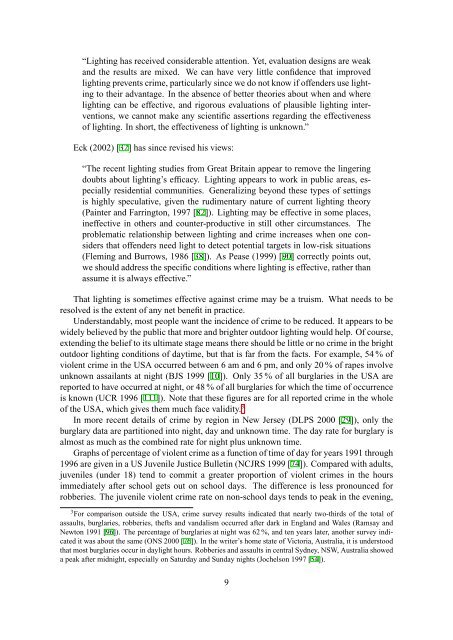outdoor lighting and crime, part 1 - Astronomical Society of Victoria
outdoor lighting and crime, part 1 - Astronomical Society of Victoria
outdoor lighting and crime, part 1 - Astronomical Society of Victoria
Create successful ePaper yourself
Turn your PDF publications into a flip-book with our unique Google optimized e-Paper software.
“Lighting has received considerable attention. Yet, evaluation designs are weak<br />
<strong>and</strong> the results are mixed. We can have very little confidence that improved<br />
<strong>lighting</strong> prevents <strong>crime</strong>, <strong>part</strong>icularly since we do not know if <strong>of</strong>fenders use <strong>lighting</strong><br />
to their advantage. In the absence <strong>of</strong> better theories about when <strong>and</strong> where<br />
<strong>lighting</strong> can be effective, <strong>and</strong> rigorous evaluations <strong>of</strong> plausible <strong>lighting</strong> interventions,<br />
we cannot make any scientific assertions regarding the effectiveness<br />
<strong>of</strong> <strong>lighting</strong>. In short, the effectiveness <strong>of</strong> <strong>lighting</strong> is unknown.”<br />
Eck (2002) [32] has since revised his views:<br />
“The recent <strong>lighting</strong> studies from Great Britain appear to remove the lingering<br />
doubts about <strong>lighting</strong>’s efficacy. Lighting appears to work in public areas, especially<br />
residential communities. Generalizing beyond these types <strong>of</strong> settings<br />
is highly speculative, given the rudimentary nature <strong>of</strong> current <strong>lighting</strong> theory<br />
(Painter <strong>and</strong> Farrington, 1997 [82]). Lighting may be effective in some places,<br />
ineffective in others <strong>and</strong> counter-productive in still other circumstances. The<br />
problematic relationship between <strong>lighting</strong> <strong>and</strong> <strong>crime</strong> increases when one considers<br />
that <strong>of</strong>fenders need light to detect potential targets in low-risk situations<br />
(Fleming <strong>and</strong> Burrows, 1986 [38]). As Pease (1999) [90] correctly points out,<br />
we should address the specific conditions where <strong>lighting</strong> is effective, rather than<br />
assume it is always effective.”<br />
That <strong>lighting</strong> is sometimes effective against <strong>crime</strong> may be a truism. What needs to be<br />
resolved is the extent <strong>of</strong> any net benefit in practice.<br />
Underst<strong>and</strong>ably, most people want the incidence <strong>of</strong> <strong>crime</strong> to be reduced. It appears to be<br />
widely believed by the public that more <strong>and</strong> brighter <strong>outdoor</strong> <strong>lighting</strong> would help. Of course,<br />
extending the belief to its ultimate stage means there should be little or no <strong>crime</strong> in the bright<br />
<strong>outdoor</strong> <strong>lighting</strong> conditions <strong>of</strong> daytime, but that is far from the facts. For example, 54 % <strong>of</strong><br />
violent <strong>crime</strong> in the USA occurred between 6 am <strong>and</strong> 6 pm, <strong>and</strong> only 20 % <strong>of</strong> rapes involve<br />
unknown assailants at night (BJS 1999 [10]). Only 35 % <strong>of</strong> all burglaries in the USA are<br />
reported to have occurred at night, or 48 % <strong>of</strong> all burglaries for which the time <strong>of</strong> occurrence<br />
is known (UCR 1996 [111]). Note that these figures are for all reported <strong>crime</strong> in the whole<br />
<strong>of</strong> the USA, which gives them much face validity. 3<br />
In more recent details <strong>of</strong> <strong>crime</strong> by region in New Jersey (DLPS 2000 [29]), only the<br />
burglary data are <strong>part</strong>itioned into night, day <strong>and</strong> unknown time. The day rate for burglary is<br />
almost as much as the combined rate for night plus unknown time.<br />
Graphs <strong>of</strong> percentage <strong>of</strong> violent <strong>crime</strong> as a function <strong>of</strong> time <strong>of</strong> day for years 1991 through<br />
1996 are given in a US Juvenile Justice Bulletin (NCJRS 1999 [74]). Compared with adults,<br />
juveniles (under 18) tend to commit a greater proportion <strong>of</strong> violent <strong>crime</strong>s in the hours<br />
immediately after school gets out on school days. The difference is less pronounced for<br />
robberies. The juvenile violent <strong>crime</strong> rate on non-school days tends to peak in the evening,<br />
3 For comparison outside the USA, <strong>crime</strong> survey results indicated that nearly two-thirds <strong>of</strong> the total <strong>of</strong><br />
assaults, burglaries, robberies, thefts <strong>and</strong> v<strong>and</strong>alism occurred after dark in Engl<strong>and</strong> <strong>and</strong> Wales (Ramsay <strong>and</strong><br />
Newton 1991 [96]). The percentage <strong>of</strong> burglaries at night was 62 %, <strong>and</strong> ten years later, another survey indicated<br />
it was about the same (ONS 2000 [76]). In the writer’s home state <strong>of</strong> <strong>Victoria</strong>, Australia, it is understood<br />
that most burglaries occur in daylight hours. Robberies <strong>and</strong> assaults in central Sydney, NSW, Australia showed<br />
a peak after midnight, especially on Saturday <strong>and</strong> Sunday nights (Jochelson 1997 [54]).<br />
9
















